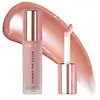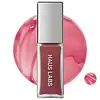Lawless Forget The Filler Lip Plumping Line Smoothing Gloss Versus Haus Labs By Lady Gaga PhD Hybrid Lip Glaze Plumping Gloss
What's inside
What's inside
 Key Ingredients
Key Ingredients

 Benefits
Benefits

 Concerns
Concerns

 Ingredients Side-by-side
Ingredients Side-by-side

Polybutene
Polyglyceryl-2 Tetraisostearate
EmollientHydrogenated Styrene/Methylstyrene/Indene Copolymer
Synthetic Beeswax
Emulsion StabilisingIsostearyl Isostearate
EmollientStearalkonium Bentonite
Gel FormingCaprylic/Capric Triglyceride
MaskingGlycerin
HumectantWater
Skin ConditioningEthylhexyl Palmitate
EmollientOctyldodecanol
EmollientSilica Dimethyl Silylate
EmollientMenthoxypropanediol
MaskingCapsicum Frutescens Fruit Extract
Skin ConditioningZingiber Officinale Root Extract
MaskingButyrospermum Parkii Butter
Skin ConditioningSynthetic Fluorphlogopite
Aroma
Helianthus Annuus Seed Oil
EmollientTocopheryl Nicotinate
AntioxidantTribehenin
EmollientPentaerythrityl Tetra-Di-T-Butyl Hydroxyhydrocinnamate
AntioxidantPrunus Amygdalus Dulcis Oil
Skin ConditioningRosa Canina Seed Oil
EmollientSimmondsia Chinensis Seed Oil
EmollientSorbitan Isostearate
EmulsifyingTocopheryl Acetate
AntioxidantTin Oxide
AbrasivePalmitoyl Tripeptide-1
Skin ConditioningPhenoxyethanol
PreservativeLactic Acid
BufferingCI 77491
Cosmetic ColorantCI 77492
Cosmetic ColorantCI 77499
Cosmetic ColorantCI 77891
Cosmetic ColorantCI 73360
Cosmetic ColorantPolybutene, Polyglyceryl-2 Tetraisostearate, Hydrogenated Styrene/Methylstyrene/Indene Copolymer, Synthetic Beeswax, Isostearyl Isostearate, Stearalkonium Bentonite, Caprylic/Capric Triglyceride, Glycerin, Water, Ethylhexyl Palmitate, Octyldodecanol, Silica Dimethyl Silylate, Menthoxypropanediol, Capsicum Frutescens Fruit Extract, Zingiber Officinale Root Extract, Butyrospermum Parkii Butter, Synthetic Fluorphlogopite, Aroma, Helianthus Annuus Seed Oil, Tocopheryl Nicotinate, Tribehenin, Pentaerythrityl Tetra-Di-T-Butyl Hydroxyhydrocinnamate, Prunus Amygdalus Dulcis Oil, Rosa Canina Seed Oil, Simmondsia Chinensis Seed Oil, Sorbitan Isostearate, Tocopheryl Acetate, Tin Oxide, Palmitoyl Tripeptide-1, Phenoxyethanol, Lactic Acid, CI 77491, CI 77492, CI 77499, CI 77891, CI 73360
Polybutene
Triisostearoyl Polyglyceryl-3 Dimer Dilinoleate
EmollientDiisostearyl Malate
EmollientOctyldodecanol
EmollientPolyglyceryl-2 Triisostearate
EmulsifyingC18-38 Alkyl Hydroxystearoyl Stearate
EmollientSilica
AbrasiveOpuntia Ficus-Indica Seed Oil
EmollientPalmitoyl Tripeptide-37
Skin ConditioningPalmitoyl Tripeptide-1
Skin ConditioningPalmitoyl Tripeptide-38
Skin ConditioningPortulaca Pilosa Extract
Skin ConditioningSqualane
EmollientEthylhexyl Palmitate
EmollientTribehenin
EmollientTocopherol
AntioxidantSucrose Cocoate
EmulsifyingTriethoxycaprylylsilane
Galactoarabinan
Caprylyl Glycol
EmollientCetearyl Ethylhexanoate
EmollientGlycerin
HumectantMalic Acid
BufferingLactic Acid
BufferingSorbitan Isostearate
EmulsifyingIsostearyl Alcohol
EmollientHexylene Glycol
EmulsifyingEthyl Vanillin
MaskingWater
Skin ConditioningIsostearic Acid
CleansingEthylhexylglycerin
Skin ConditioningSodium Sulfate
Phenoxyethanol
PreservativeCI 77491
Cosmetic ColorantCI 77891
Cosmetic ColorantCI 15850
Cosmetic ColorantCI 19140
Cosmetic ColorantPolybutene, Triisostearoyl Polyglyceryl-3 Dimer Dilinoleate, Diisostearyl Malate, Octyldodecanol, Polyglyceryl-2 Triisostearate, C18-38 Alkyl Hydroxystearoyl Stearate, Silica, Opuntia Ficus-Indica Seed Oil, Palmitoyl Tripeptide-37, Palmitoyl Tripeptide-1, Palmitoyl Tripeptide-38, Portulaca Pilosa Extract, Squalane, Ethylhexyl Palmitate, Tribehenin, Tocopherol, Sucrose Cocoate, Triethoxycaprylylsilane, Galactoarabinan, Caprylyl Glycol, Cetearyl Ethylhexanoate, Glycerin, Malic Acid, Lactic Acid, Sorbitan Isostearate, Isostearyl Alcohol, Hexylene Glycol, Ethyl Vanillin, Water, Isostearic Acid, Ethylhexylglycerin, Sodium Sulfate, Phenoxyethanol, CI 77491, CI 77891, CI 15850, CI 19140
Ingredients Explained
These ingredients are found in both products.
Ingredients higher up in an ingredient list are typically present in a larger amount.
Ci 77491 is also hydrated iron III oxide. It's sole purpose is to give a red/pink hue to products.
Iron III oxides are classified as inorganic chemicals for coloring.
Synthetically created Ci 77491 is considered safer than those naturally found. This is because the synthetically created version may contain less impurities. Iron oxides are generally non-toxic and non-allergenic.
Learn more about CI 77491Ci 77891 is a white pigment from Titanium dioxide. It is naturally found in minerals such as rutile and ilmenite.
It's main function is to add a white color to cosmetics. It can also be mixed with other colors to create different shades.
Ci 77891 is commonly found in sunscreens due to its ability to block UV rays.
Learn more about CI 77891Ethylhexyl Palmitate, also known as octyl palmitate, is created from 2-ethylhexyl alcohol and palmitic acid. It is a fatty acid ester.
The fatty acid content of Ethylhexyl Palmitate makes it an emollient. Emollients help soften and hydrate your skin by trapping moisture within.
Ethylhexyl Palmitate is also used to help improve the texture of cosmetics. It helps other ingredient dissolve in products and help disperse ingredients more evenly.
You'll likely find this ingredient in sunscreen, as it is often used to mix UV-blocking ingredients such as avobenzone and ethylhexyl triazone.
It can also help stabilize the fragrances in a product as a fragrance fixative.
Ethylhexyl Palmitate can be used to substitute mineral oil.
Due to its high fatty acid content, it may not be fungal-acne safe.
Learn more about Ethylhexyl PalmitateGlycerin is already naturally found in your skin. It helps moisturize and protect your skin.
A study from 2016 found glycerin to be more effective as a humectant than AHAs and hyaluronic acid.
As a humectant, it helps the skin stay hydrated by pulling moisture to your skin. The low molecular weight of glycerin allows it to pull moisture into the deeper layers of your skin.
Hydrated skin improves your skin barrier; Your skin barrier helps protect against irritants and bacteria.
Glycerin has also been found to have antimicrobial and antiviral properties. Due to these properties, glycerin is often used in wound and burn treatments.
In cosmetics, glycerin is usually derived from plants such as soybean or palm. However, it can also be sourced from animals, such as tallow or animal fat.
This ingredient is organic, colorless, odorless, and non-toxic.
Glycerin is the name for this ingredient in American English. British English uses Glycerol/Glycerine.
Learn more about GlycerinLactic Acid is another well-loved alpha hydroxy acid (AHA). It is gentler than glycolic acid but still highly effective.
Its main role is to exfoliate the surface of the skin by loosening the “glue” that holds dead skin cells together. Shedding those old cells leads to smoother, softer, and more even-toned skin.
Because lactic acid molecules are larger than glycolic acid, they don’t penetrate as deeply. This means they’re less likely to sting or irritate, making it a great choice for beginners or those with sensitive skin.
Like glycolic acid, it can:
Lactic acid also acts as a humectant (like hyaluronic acid). It can draw water into the skin to improve hydration and also plays a role in the skin's natural moisturizing factor (NMF) in the form of sodium lactate.
Studies show it can boost ceramide production to strengthen the skin barrier and even help balance the skin’s microbiome.
To get results, choose products with a pH between 3-4.
Lower strengths (5-12%) focus on surface exfoliation; higher strengths (12% and up) can reach deeper in the dermis (deeper, supportive layer) to improve skin texture and firmness over time.
Though it was originally derived from milk, most modern lactic acid used in skincare is vegan. It is made through non-dairy fermentation to create a bio-identical and stable form suitable for all formulations.
When lactic acid shows up near the end of an ingredient list, it usually means the brand added just a tiny amount to adjust the product’s pH.
Legend has it that Cleopatra used to bathe in sour milk to help reduce wrinkles.
Lactic acid is truly a gentle multitasker: it exfoliates, hydrates, strengthens, and brightens. It's a great ingredient for giving your skin a smooth, glowing, and healthy look without the harshness of stronger acids.
Read more about some other popular AHA's here:
Learn more about Lactic AcidOctyldodecanol is a fatty alcohol. It is primarily used to enhance the texture of products.
As an emulsifier, Octyldodecanol helps prevent the oils and waters from separating. It also prevents ingredients from creating foam when shaken.
Octyldodecanol is created by reducing fatty acid to an alcohol.
Due to its high molecular weight, it does not get absorbed into the skin.
Learn more about OctyldodecanolPalmitoyl Tripeptide-1 is also known as pal-GHK. It is made up of 3 amino acids and palmitic acid, a fatty acid that helps it absorb into skin more easily.
This peptide is as a signal peptide, meaning it tells the skin to produce more collagen. Collagen is the key protein that helps form the skin's structure and keep it plump, firm, and hydrated.
By boosting collagen production, this ingredient supports a stronger skin barrier and helps reduce the appearance of wrinkles.
You'll most likely see this ingredient paired with Palmitoyl Tetrapeptide-7 in the well-known Matrixyl 3000 complex. While results from in-house testing should be viewed cautiously, this peptide duo is among the most studied and widely used in modern skincare.
Due to its palmitic acid base, this ingredient may not be safe for Malassezia folliculitis.
Read more about other common types of peptides here:
Learn more about Palmitoyl Tripeptide-1Phenoxyethanol is a preservative that has germicide, antimicrobial, and aromatic properties. Studies show that phenoxyethanol can prevent microbial growth. By itself, it has a scent that is similar to that of a rose.
It's often used in formulations along with Caprylyl Glycol to preserve the shelf life of products.
Polybutene is used to help control the viscosity of a product. This just means it helps adjusts the texture.
It is a polymer and does not get absorbed into the skin due to its large size.
Studies found this ingredient did not irritate skin in concentrations below 15%.
Learn more about PolybuteneSorbitan Isostearate is an emulsifer and cleaning agent. It is created from isostearic acid and sorbitol.
As an emulsifier, Sorbitan Isostearate prevents oils and water from separating.
Due to its isostearic acid base, it may not be safe for Malassezia or fungal acne.
Learn more about Sorbitan IsostearateTribehenin comes from glycerin and behenic acid.
It is used as an emollient, or moisturizer. Emollients form a thin barrier on skin to prevent moisture from escaping.
This ingredient may not be Malassezia folliculitis, or fungal-acne safe.
Learn more about TribeheninWater. It's the most common cosmetic ingredient of all. You'll usually see it at the top of ingredient lists, meaning that it makes up the largest part of the product.
So why is it so popular? Water most often acts as a solvent - this means that it helps dissolve other ingredients into the formulation.
You'll also recognize water as that liquid we all need to stay alive. If you see this, drink a glass of water. Stay hydrated!
Learn more about Water